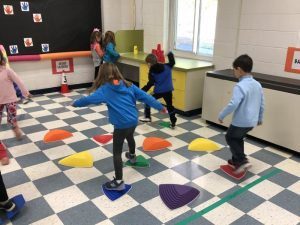Active Learning Opportunities
Incorporate physical activity before, during, and after the school day, as well as into daily lesson plans.
Read More Sensory spaces are a fun and engaging way for children to get their wiggles out, refocus during a transition or self-soothe after facing a difficult challenge. These paths are made to be colorful and playful and turn a passive environment into an active one. Not only do they add more physical activity to a child’s day, but they can also be designed to help them practice a variety of skills and just play. Exploring senses through unstructured play helps children identify emotions to better manage stress, self-regulate and control their impulses. Sensory-based activities can also help develop organization skills through physical and visual orientation activities.
Sensory spaces are a fun and engaging way for children to get their wiggles out, refocus during a transition or self-soothe after facing a difficult challenge. These paths are made to be colorful and playful and turn a passive environment into an active one. Not only do they add more physical activity to a child’s day, but they can also be designed to help them practice a variety of skills and just play. Exploring senses through unstructured play helps children identify emotions to better manage stress, self-regulate and control their impulses. Sensory-based activities can also help develop organization skills through physical and visual orientation activities.
Carve out some time to plan what your path will look like. Research sensory path or movement hallways and pick out your favorite stations and activities. Get creative! Consider a variety of stations and activities that touch on various skills.
Choose a space that is both accessible to all children and not a disruption to others when in use. Sensory and movement paths can also be modified for an office, classroom or space at home for mid-day brain breaks or to help children refocus.
Create a team and make it an activity where all can play a part.
Starting small is okay! At school: start with a classroom path and then widen to a school-wide initiative to engage children and add more playful time into the day. At Home: set up one or two stations in the space that family uses most and work your way into adding more stations or stations in other rooms.
Consider the space and the materials you use. Laminating any pieces you make on your own will keep them in good condition for longer. For outdoor paths, talk with your administrator about using paint or consider chalk for a temporary path and then change it up! Similarly, if placing in a hallway or heavily trafficked space – vinyl tape or decals are longer-lasting – where for classrooms or rooms in the house, masking tape on the carpet or floor can be more temporary, but still get the job done!
As with anything, think of safety first! Be sure any routes you create are safe for children (ex. corners or intersecting hallways) and there is adequate supervision when in use. Also be sure to secure anything that is on the floor or wall to avoid slips or falls. If you need a flexible option, contact paper is great – just be sure to clean the area before placing to ensure a nice stick!
Keep it colorful and fun! Ensure there are developmentally appropriate signs or directions throughout like arrows for directions, alternative footprints for jumping in and out, or pictures such as a crab for a crabwalk or bear for a bear crawl.
Take a video of a teacher or child using the course. Share with teachers, other school staff and parents to demonstrate how to use and encourage modeling its use for brain breaks, sensory walk to support self-regulation when upset, during parent pick up and more.
For more activities and ideas like this one, be sure to sign up for our news and updates. And if you like what you see, please donate to support our work creating more ways to help build a healthier future for kids.
Categories: Physical Activity & Play, Social-Emotional Health, At Home, At School, Digital Resource